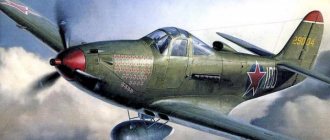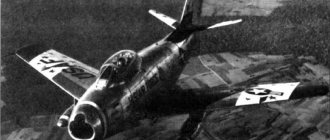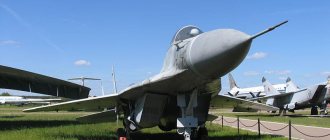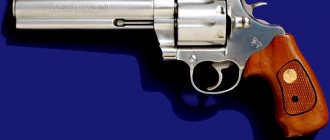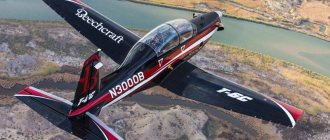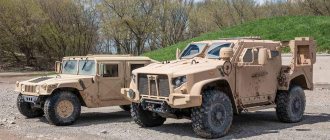The Bell P-63 Kingcobra was the only single-engine U.S. Army fighter developed after Pearl Harbor to enter production before the end of World War II. The Kingcobra was an attempt to significantly improve the flight-tactical characteristics of the P-39 Airacobra fighter, and, although outwardly reminiscent of its predecessor, it was essentially a new aircraft. The main innovations were the installation of a more powerful engine and the use of a laminar wing profile. The transitional stage to the new machine was the XP-39E - a modified Airacobra, three copies of which were tested in 1941. But even before the first flight of the XP-39E, in June 1941, two prototypes of the new XP-63 fighter were ordered, which retained the " Allison" V-1710-47, but increased in size. The engine received a second stage of supercharging, which made it possible to raise the ceiling by a good 3000 m. In September 1942, even before the first flight of the XP-63, the US Army Air Force ordered a production batch under the designation P-63A. The armament was to match that installed on the P-39Q: a 37 mm cannon firing through the propeller shaft, and 4 12.7 mm machine guns (2 synchronized and 2 in underwing gondolas).
The first XP-63 prototype entered testing on December 7, 1942, the second on February 5, 1943, but both vehicles were soon lost in accidents. Nevertheless, work continued - in April 1943, the standard for the series took off for the first time. The V-1710-93 engine (1500 hp) was installed on it. Serial production in Buffalo began in October 1943.
Main modifications of the Bell P-63:
- R -63 A - engine V-1710-93. Armament: 37-mm Oldsmobile M4 cannon (30 rounds of ammunition) and 4 12.7-mm machine guns (200 rounds per barrel for synchronized machine guns and 900 for underwing ones). The aircraft could carry a 285-liter or 663-liter PTB, or a 227-kg bomb under the fuselage. From the R-63A-6 series, two underwing holders for 227 kg bombs were installed, and on the R-63A-8 the pilot’s protection was strengthened (armor weight increased from 40 to 86 kg). Starting with the R-63A-9 series, a new 37-mm M10 cannon with 58 rounds of ammunition was installed, and the R-63A-10 received under-wing launchers for NAR. Until December 1944, 1,725 P-63A were built. 24 aircraft were converted into two-seat TR-63A trainers, and 100 into RP-63A target aircraft. All weapons were removed from them and thickened casing was used, and fire was fired at them with special bullets made of a brittle alloy of lead and graphite. Sensors under the skin recorded hits, and they were signaled by a lamp mounted on the propeller hub.
- R -63 C - V-1710-117 engine with a water-alcohol mixture injection system, which developed a power of 1800 hp in emergency mode. From the R-63S-5 series, the aircraft received a ventral ridge. Since December 1944, 1227 aircraft have been produced. 200 of them were converted into RP-63C target aircraft.
The R-63B variant for the Packard V-1650-5 engine remained in the project. The P-63D with the V-1710-109 engine and an increased wing span was built in a single copy, and the P-63E with the V-1710-119 engine and an increased wing span was built in 13 copies. They also built two P-63F aircraft with the V-1710-135 engine, an enlarged fin and an extended ventral ridge, and in 1946 they produced 30 RP-63G target aircraft with V-1710-135 engines.
A total of 3,303 R-63s were produced, the vast majority of which were supplied under Lend-Lease to the USSR and France.
Part three ANTARCTICAChapter 5. P-63 “KINGCOBRA”
Of all the aviation equipment supplied by the Americans to the USSR during the war, only one type of aircraft was equipped with four-bladed propellers - these were fighters of the same type. The Kingcobra, unlike the more famous, albeit less advanced Airacobra, was produced by the Americans exclusively on Soviet orders and in accordance with Soviet technical requirements. It is not surprising that the Americans themselves have always considered the P-63 a “Russian aircraft”, since almost the entire “circulation” of this aircraft ended up in the USSR (it was never accepted into service in America itself due to the presence of similar types of fighters in the US Air Force - "Mustang", "Corsair" and some others).
Bell P-63 "Kingcobra"
Possessing a very high speed, long flight range and a decent practical ceiling, the P-63 was an excellent interceptor, but since by the time deliveries began the war was clearly coming to an end, not a single vehicle of this type made it to the front - Stalin saved these fighters for other things. “Kingcobras,” as one of the memoirists of that time put it, could become Stalin’s Main Reserve in case of an unpredictable change in the military-political situation and the outbreak of war by the United States. All air defense units of the USSR were equipped with them - of all the fighters in service in the Soviet Union, only the Kingcobra could “reach” the main US strategic bomber, the B-29 Superfortress, in the sky. Thus, by 1947, all 2,500 P-63 fighters that fell into the hands of Stalin were in full combat readiness. Naturally, these aircraft took part in all overt and covert operations of the Soviet Air Force carried out during that period, and one of them was the first Soviet Antarctic expedition under the leadership of Admiral Papanin.
Bell P-63 "Kingcobra" at the assembly point
As anyone interested knows, the Kingcobra was perfectly suited for “working” in difficult and even very difficult weather conditions, including polar ones. During the war, absolutely all P-63s were ferried under their own power along ALSIB (from the USA to the USSR), and along this entire complex route, more than five thousand kilometers long (excluding the flight to the Bering Strait over Alaska), out of 2,500 ferried in the fall of 1944 - in the spring of 1945, our pilots lost only 7 aircraft - an indicator simply phenomenal, considering that incomparably more other types of aircraft were lost on the way to the front. The difficulties the ferrymen had to face over the vast Siberian expanses, which at this time of year were more like the icy deserts of Antarctica, can be imagined from the memoirs of I. Mazuruk himself. Here are his words, taken from a book of memoirs published in 1976:
“In December 1944, the group of 15 Kingcobras I led, due to the fact that the destination Seymchan airfield was closed by fog, had to be landed on the ice of the Kolyma River near the village of Zyryanka... The thermometer showed -53* Celsius, and we, naturally, had no heaters. did not have. But in the morning the entire group took off safely thanks to the flight mechanic of the leading A-20 aircraft, Gennady Sultanov, who called on local residents for help. All night long, the adult population of Zyryanka burned iron stoves with wood, installed under the Kingcobras, covered with large pieces of tarpaulin. Subsequently, the same Sultanov came up with the idea of using ordinary squibs to quickly warm up in emergency situations...”
Ferrying American aircraft along the Alsib highway
By the way, the Americans never thought of this. However, they had their own factory-made heaters, and besides, for each of their planes, unlike us, there were literally ten technicians and mechanics, each of whom serviced a certain piece of equipment. Almost all “Kingcobras” delivered to the USSR were equipped with a radio compass, which greatly facilitated navigation at night and in the clouds, and in 1945, versions equipped with search radar stations began to arrive, which made it possible not only to fly “blindly”, but also to reach targets located in 50-70 kilometers beyond the horizon, as well as some devices signaling a sudden attack from behind. The improved engine starting system significantly expanded the range of “operating temperatures”, and the domestically produced KM-10 oxygen mask allowed the pilot to feel excellent at altitudes of up to 16 km (16 km is the theoretical ceiling, practical – 12 km, which was also excellent in those conditions) .
Bell P-63 "Kingcobra" in combat. But this is just the artist’s fantasy; this plane did not fight on the German front.
So, you and I can definitely notice that the Kingcobra, if not the ideal combat aircraft for the Antarctic theater of operations, is in any case the most suitable of many others that existed at that time all over the world. In any case, Stalin, according to the most informed historians, did not have anything better until the moment the MiG-15 jet was put into operation. Considering the rich experience of the famous Mazuruk in polar affairs in general and the successful operation of the “Kingcobra” in the harsh conditions of Chukotka and Siberia in particular, we can safely assume that already in 1946 this “man and hero”, having received general’s shoulder straps from the hands of Joseph Vissarionovich, commanded the highly effective air defense system of the then military Antarctic Soviet base on Dronning Maud Land.
P-63 "Kingcobra"
>> FURTHER STALIN'S ANTARCTIC ALLIES
P-39E IS NOT A KINGCOBRA YET
Many consider the American P-63 Kingcobra fighter to be a modification of the famous Airacobra (P-39). In fact, this is not true. Although, of course, the evolutionary process began with the P-39, it ultimately led to the creation of an essentially new vehicle, which retained only the general layout of its predecessor.
It all started with an attempt by designers to significantly improve the flight characteristics of the Airacobra fighter. The P-39E modification was to be the first to introduce significant changes. One of the ways seemed quite traditional - to increase engine power. Instead of the standard V-1710 engine for the Airacobra, the V-1430 was included in the “Model 23” project, as the company called it. But the second approach in those years looked like a clear novelty: they were going to reduce aerodynamic drag by introducing a wing with laminar flow. Compared to the wing profile previously used on the Cobra, it had a pointed tip and a maximum height shifted back. While providing benefits in reducing drag, such a wing, on the other hand, reduced lift, which should have a negative impact on takeoff and landing performance. In addition, the laminar wing only worked if the profile was strictly maintained. Therefore, the designers actually had to design a new wing with a different power set.
It did not have stringers, and rigidity was provided by thickened skin. In addition, the project included an extension of the rear fuselage, a modified tail and a reinforced landing gear. The P-39E's estimated maximum speed was 632 km/h. Documentation for the “Model 23” was prepared by the beginning of February 1941 and submitted to the War Ministry for consideration. In April, the military ordered two prototypes of the new modification.
The first sample of the XP-39E took off from the factory airfield in Niagara Falls on February 21, 1942. The V-1430 engine was not ready on time, and the car was “redesigned” back to V-1710-47. The fighter had rectangular wingtips (all other versions of the Airacobra had rounded ones) and an angular tail. The air intakes of the radiators at the root of the wing were enlarged, as were the radiators themselves.
The tests were initially successful, but on the 35th flight the plane was unable to recover from a spin (this was a “family” disease of the P-39). A second copy was prepared to replace it, slightly different in the outline of the vertical tail, and with a slightly more powerful engine. It also flew only briefly, and on May 15 it crashed during its 27th flight.
On May 27, to replace the lost one, the War Ministry ordered a third model, again with new plumage. It took off on September 19, 1942. By this time, a second aircraft had been restored from the surviving wreckage and was also involved in testing. However, on February 8, 1943, she was “banned” for the second time.
But by this moment it was already clear that, as they say, “the trick failed.” The fighter's speed increased, but not as much as expected. But the landing speed increased, the takeoff takeoff was prolonged, the rate of climb and maneuverability deteriorated, and the service ceiling decreased. The P-39E was rejected, and plans for mass production of this modification were abandoned.
However, the very idea of introducing a laminar flow wing continued to remain promising. Therefore, in parallel with the “Model 23”, they began to develop a project for the “Model 33”, which was already a new fighter, but retained the same layout with the engine located behind the cockpit and rotation transmitted to the propeller through a long shaft and a forward gearbox.
The first XP-39E at the airfield. The second example of the XP-39E with an angular vertical tail and fork. The third copy of the XP-39E also had an angular vertical tail, but of greater height.
V. R. Kotelnikov FIGHTER P-63 “KINGCOBRA”
XP-63, first prototype, late 1942. Soviet Air Force P-63A-8.
P-63F during testing, 1945 P-63C-5 on the ALSIB track, 1945 P-63C-5 of the Soviet Air Force, 1945 Dear aviation enthusiasts! This issue will introduce you to the American Bell P-63 Kingcobra fighter, which was widely used in the Soviet Air Force. It was used in combat in the Far East in August 1945 and served in our aviation until the early 1950s. Further in 2012, issues of the “Aviation Collection” will be published, dedicated to the Soviet biplane fighter I-15, which fought at Lake Khasan and in Spain, the American military transport aircraft C-17A, the Tupolev “cruiser” R-6 (including KR-6) and Soviet landing gliders of the Great Patriotic War.
Attention readers!
In order to avoid discrepancies with the cited documents, instead of the term “mass” in the text, “weight” (in kg) is used, and the power is given not in kW, but in hp, which corresponds to the terminology of that time. The relationship between these values and modern ones is as follows: 1 kg = 9.8 n; 1 hp = 0.736 kW.
